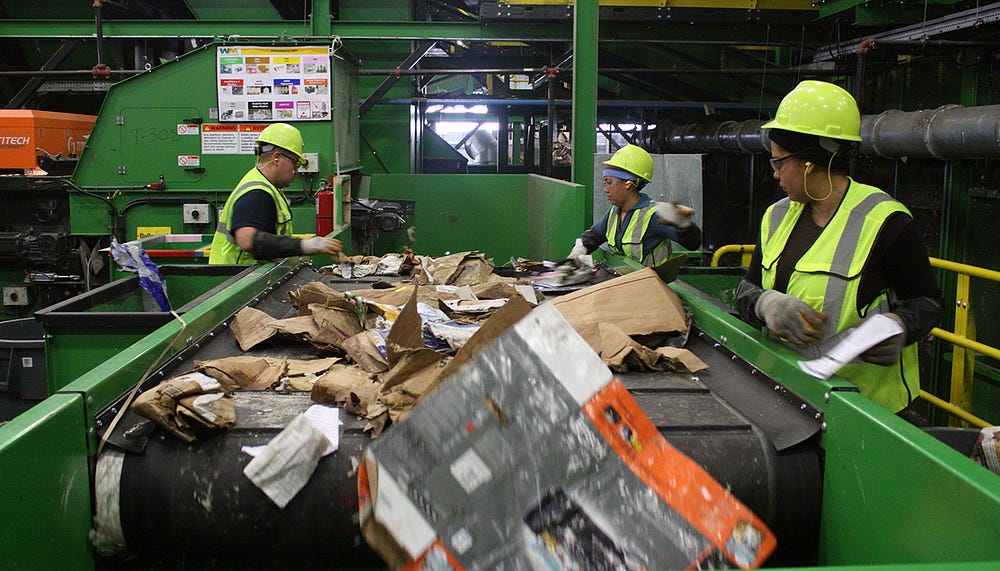
For most people, recycling is a good thing. But for some, the impacts of recycling aren’t all positive. In fact, those 94 percent of Americans who recycle have devastating impacts on people of color.
“For those who make environmental and industrial decisions, communities of color — regardless of their class status — have been considered to be throw-away communities; therefore, their land [is most often] used for garbage dumps, waste transfer stations, incinerators, dirty materials recovery facilities, and other waste disposal infrastructure,” says Dr. Robert D. Bullard at Texas Southern University, who has conducted pioneering research and leadership on environmental justice.
In other words, recycling has environmental benefits and also raises some serious issues that all communities must consider to ensure that no one is bearing too much of the trash burden.
Dirty Recycling Does Exist
Community recycling systems come in two main types — and one inherently brings more environmental-justice problems than the other.
When garbage trucks come to collect your curbside recycling bins, their destination is usually a waste transfer station. At the transfer station, waste is sorted:
- Recyclables go to a Materials Recovery Facility (MRF)
- Organic waste goes to a municipal composter
- Everything else is taken to a lanfill or incinerator
Rural areas may have some combination of these in one or two locations.
At a MRF (rhymes with “smurf”), recyclables are sorted by type (paper, glass, plastic, etc.), then sent out to facilities that specialize in doing the actual recycling.
Here’s where the key differences lie. MRFs come in two types: clean or dirty.
In a clean MRF, recyclable materials arrive at the facility already separated from regular trash — generally by individuals who sorted them at home. Either all recyclables will arrive commingled, which is called single-stream recycling, or further sorted by separating fiber (paper and cardboard) from containers (metal, plastic, and glass), known as dual-stream recycling. Any additional pre-sorting is known as multi-stream recycling.
Along with the environmental benefits recycling brings come deep concerns that all communities must consider to ensure that no one is bearing too much of the trash burden.
Generally speaking, the more pre-sorting that occurs before the recyclables arrive at the MRF, the cleaner the MRF is. However, single-stream MRFs using best practices to recover as many recyclables as possible can still be top-notch.
A dirty MRF is one where trash and recyclables arrive mixed together, no at-home separation required. It’s the easiest for households because it requires no thinking whatsoever. Just toss everything into the garbage with the knowledge that it will all be sorted right at the end.
Or will it?
The city of Houston is currently fighting off plans for a dirty MRF. The proposed “One Bin for All” initiative would get rid of all recycling programs in the city and build one giant dirty MRF that would accept recyclables mingled with trash for sorting.
The problem with this plan is twofold, says Melanie Scruggs, Houston program director with the Texas Campaign for the Environment (TCE). First, she says, “recyclers are looking for materials that are clean and dry. The biggest problem when you combine trash and recycling is that it contaminates the recyclables and diminishes their value.”
Since China and other major buyers of US recyclables no longer want dirty materials that aren’t cost-effective to recycle, US waste management companies have become much more careful about what they send to recyclers. More often than not, they’ll divert dirty recyclables to landfills or incinerators as a precaution.
Dirty MRFs automatically cause excessive recycling contamination. Therefore, it’s very appealing for operators to pair them with incinerators, says Scruggs.
She points to a dirty MRF in Indianapolis that was trying to get a municipal contract last year. Representatives claimed the facility would recycle 100 percent of what went in, but it actually ended up incinerating 80 percent and recycling only 20.
“Dirty MRFs don’t have to set a particularly high recycling target and can still call themselves a recycling facility,” even with an incinerator on site, Scruggs says.
Incinerators spew a variety of toxins into the air, including carcinogenic dioxin, according to the Global Alliance for Incinerator Alternatives (GAIA). In addition, they create toxic “bottom ash” containing heavy metals, dioxin, and other pollutants that must then be landfilled.

And while many incineration projects tout their “waste-to-energy” benefits, these are more than offset by the fact that incinerators emit more carbon dioxide per megawatt-hour than any fossil- fuel-based power source, including coal plants, according to GAIA.
Dirty MRFs also often tend to be located in communities of color. Houston’s proposed dirty MRF is no exception.
“The city was originally going to build [the dirty MRF] at an existing landfill or transfer station, which are all located in predominantly minority communities,” says Scruggs. “Houston’s trash is distributed to nine landfills and three recycling facilities right now. We don’t need to consolidate it into one neighborhood.”
But when Dr. Bullard, TCE, and their allies raised this issue with the city, “local officials were quick to respond that Houston would not be burdening one community like that,” says Scruggs. “They changed their tune very quickly.”
Trucks Bring Trash and Air Pollution In
New York City residents and visitors produce over 20,000 tons of solid waste every single day, according to the New York City Environmental Justice Alliance (NYC-EJA), a network of local environmental- justice organizations.
“About 75 percent of that solid waste is processed in just a handful of communities: specifically in Southeast Queens, South Bronx, and North Brooklyn,” says Priya Mulgaonkar, a policy organizer with NYC-EJA. The population in these areas is primarily African-American and Latino.
The resulting concentration of waste transfer stations and MRFs has been making people in those neighborhoods sick — literally.
“Especially in the summertime, when these facilities aren’t being closed properly, then people live and breathe garbage,” she says. “Some of the [waste-hauling] trucks aren’t sealed, so trash flies off during transport. It’s right in people’s backyards.”
Further exacerbating the pollution in these areas are the trucks that carry trash and recyclables to and from the facilities.
Mulgaonkar notes that the commercial waste haulers, in particular, tend to be very inefficient about their routes: “These huge diesel trucks chug pollution into the streets, traveling an unnecessary amount of miles in these three main communities.”
It’s not a matter of luxury for us. It’s about, ‘Can my kid breathe? Can I breathe? Can we have a healthy and happy family here in the places we have to live?’
Due in part to the number of garbage and recycling trucks that rumble in and out of the South Bronx, a 2013 University of New York study found the area to have one of the highest asthma rates in the US.
Mulgaonkar notes that this extra truck traffic also contributes to safety concerns.
“With over 250 carters competing to pick up enough waste to make a profit, drivers are often pressured by their bosses to speed, cut corners, and to ignore traffic signals,” she says. “This puts pedestrians at risk on the roads, and is also really unfair to the workers themselves, who are largely people of color, undocumented, and formerly incarcerated folks, and who often work 12–14 hour shifts.”
Fighting for Breath
Thanks to activist-led initiatives, municipalities across the country are waking up to the fact that there are ways to recycle that don’t put an undue burden on one neighborhood over another.
The Texas Campaign for the Environment is pushing for the state to embrace true zero waste — no dirty MRFs or incinerators. Austin and Dallas now aim to divert 90 percent of their trash from landfills and incinerators by 2020, and San Antonio aims to divert 60 percent by 2025. San Antonio and Austin have mandatory recycling and municipal curbside composting already in place, and Dallas is working toward both. TCE is pushing for Houston to adopt a zero-waste plan as well.
For those who make environmental and industrial decisions, communities of color — regardless of their class status — have been considered to be throw-away communities; therefore, their land [is most often] used for garbage dumps, waste transfer stations, incinerators, dirty materials recovery facilities, and other waste disposal infrastructure.
Dr. Bullard, TCE, and their allies have fought off One Bin for All — so far. Though the plan could come back, the city just signed a two-year curbside recycling contract that has stalled the dirty MRF.
NYC-EJA and its allies have been uniting their efforts around the Transform Don’t Trash NYC campaign, advocating for a cleaner, healthier waste system in New York City. In particular, they are calling for the city to award commercial waste-hauling contracts to companies that have the highest environmental standards, worker-safety and health standards, and worker salaries.
In 2006, NYC-EJA and other organizations worked closely with then-Mayor Bloomberg’s office to develop a 20-year city-wide waste-disposal policy that, for the first time, relied on environmental- justice principles. The plan called for a reduction in waste facilities and truck traffic in overburdened communities, and a reduction in overall waste processing.
Unfortunately, Mulgaonkar says that the plan has yet to be fully implemented. The groups continue to pressure city leaders to fulfill the promises they made in 2006.
Because, as Kellie Terrie, a resident of the South Bronx, told Transform Don’t Trash, environmental justice around recycling and waste hauling is critical.
“It’s not a matter of luxury for us. We don’t have a choice,” Terrie said. “It’s about, ‘Can my kid breathe? Can I breathe? Can we have a healthy and happy family here in the places we have to live?’ Environmental justice is not an option for us. It’s a life-or-death issue.”







